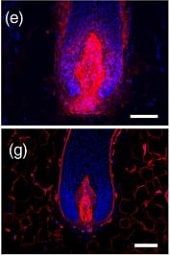When it comes to hair cloning and tissue engineering, 3D culturing related research is booming. The 3D culturing of cells can occur via scaffold techniques or via scaffold free techniques such as 3D spheroids.
Update: March 11, 2022 — 3D bioprinting of a gelatin-alginate hydrogel for tissue-engineered hair follicle regeneration. This new approach from Chinese scientists permits the controllable formation of self-aggregating spheroids of dermal papilla cells. It also leads to the initiation of epidermal-mesenchymal interactions, which results in hair follicle formation in vivo.
Recent Studies on 3D Culturing of Hair Cells
Over the past few months, a number of studies have come out in relation to 3D culturing of hair cells (in particular, dermal papilla cells). Below, I list them from most recent to oldest.
July 27, 2020 — A new study from North Carolina State University compared 3D versus 2D cultured dermal papilla cells. The 3D dermal papilla cells in a scaffold performed best in regrowing hair. More interestingly, the scientists also studied microRNAs (miRNAs) in dermal exosomes from both the 2D and 3D DP cells. The team then identified one (miR-218-5p) in particular as a key promoter of hair growth. Per lead study investigator Dr. Ke Cheng, the best part is that MiRNAs can be developed into small molecule-based drugs, including creams. A much easier feat in comparison to cell growth, expansion and injection.
June 16, 2020 — Several people in the comments mentioned a new paper titled: “Generation of human hair follicle organoids in vitro and ex vivo by co-culture of primary human hair matrix keratinocytes and dermal papilla fibroblasts”. One of the co-authors of this paper is Dr. Ralf Paus. This experiment succeeded in human scalp skin and not just in mice (h/t reader “Joe”).
April 28, 2020 — Culturing human hair follicle dermal papilla cells in a 3D self-assembling peptide scaffold. The results of this study suggest a new potential 3D culture platform based on a self-assembling peptide scaffold called RAD16-I. This method successfully created hair follicle dermal papilla cells.

April 15, 2020 — A new paper on reconstructed human skin with working hair follicles. Co-authors include the renowned Dr. Roland Lauster and Dr. Gerd Lindner.
The results section has an interesting part titled “Comparison of cultured neopapillae spheroids with scalp hair dermal papillae”. Several of the images of the 3D cultured hair follicles are shown on the right. Neopapillae spheroids were constructed from expanded self‐aggregating dermal papilla cells.
December 26, 2019 — Tissue engineering strategies for human hair follicle regeneration. This review analyzes the various research approaches being developed to tackle hair follicle bioengineering. Lots of discussion about 3D culturing, various types of scaffolding and dermal papilla trichogenicity. For the scientifically inclined readers, Table 1 is quite useful and I am pasting a small part of it here:

December 13, 2018 — An important paper with Dr. Angela Christiano, Dr. Colin Jahoda and Dr. Etienne Wang as co-authors. They created 3D-printed hair follicle molds using a biomimetic approach. I covered this work in detail in my 2018 post on biomimetic tissue engineering of hair follicles.
October 22, 2013
3D Spheroid Culturing of Dermal Papilla Cells
This week seems to be full of interesting developments, but the below news made all the global headlines.
Dr. Angela Christiano (Columbia University — US) and Dr. Colin Jahoda (Durham University — UK) just released their latest findings on hair follicle culturing. Their main discovery involves using a “hanging-drop” method of 3D spheroid culturing of dermal papilla cells. As opposed to a regular 2D petri dish culturing method that had failed in the past.
This new 3D method has shown significant success. However, it is still a years away from being able to be used in humans with consistent and safe results.
Media Coverage
For more, see this video with the hair follicle blessed Dr. Christiano. Edit: Per the Fox News video in the link at the bottom, it seems like she wears a wig and suffers from Alopecia Areata.
An audio interview from BBC with Dr. Colin Jahoda
And now some other links to their findings: